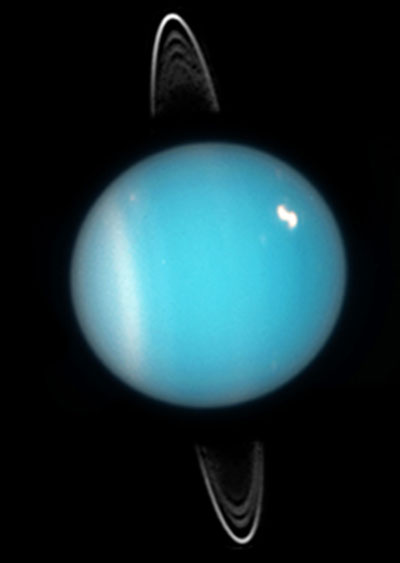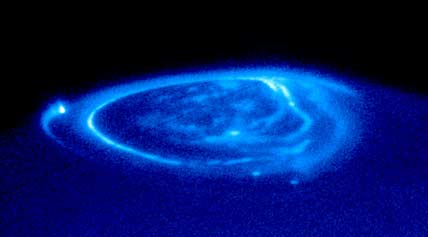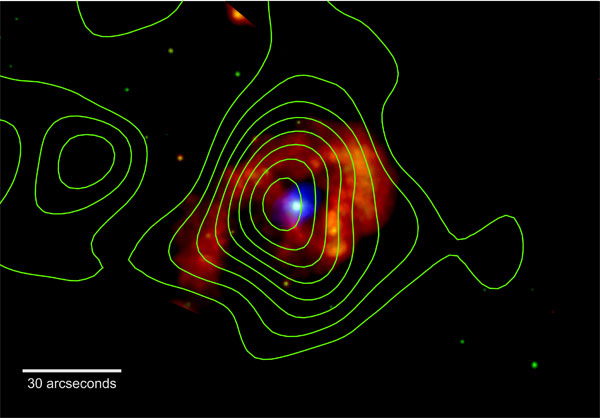Cataclysmic Impact Shaped Evolution for Ice Giant Uranus

The Hubble Space Telescope captured this shot of Uranus in 2005.
NASA / ESA / and M. Showalter
Scientists have long known that the strange tilt of the Uranus could only be explained by a terrific impact. Uranus is unlike any other solar system planet in that it’s tipped on its side: The ice giant spins at right angles to the plane in which the planets orbit, so that its poles take turns basking in sunlight. Now, Jacob Kegerreis (Durham University, UK) and colleagues have used high-resolution computer simulations of more than 50 different impact scenarios to see how this could have occurred.
The team concludes that the collision, which took place roughly 4 billion years ago, was probably with a rock-and-ice protoplanet at least twice Earth’s mass. Even though the impact was powerful enough to knock the planet over, Uranus managed to hold on to most of its gaseous atmosphere. Some of the lost atmosphere may have helped form the thin rings that encircle the planet today.
The historic collision helps explain a number of the ice giant’s more curious attributes. Its atmosphere is incredibly cold, even for being so far out from the Sun: -216°C (135 K). The simulations suggest that the impactor’s debris could have formed a thin shell of ice within Uranus, near the edge of its ice layer, that traps heat emanating from the planet’s core. The impact could also explain the planet’s tilted and off-center magnetic field.
Read more in Durham University’s press release. The study appears in the Astrophysical Journal.
Jupiter’s Moons and Jupiter’s Aurorae
Jupiter displays beautiful aurorae, created when charged particles rain down along magnetic field lines and interact with the planet’s upper atmosphere. But unlike the ethereal Northern Lights on Earth, Jupiter’s nearest and largest moons contribute charged particles to the giant planet’s aurorae, creating permanent spots of light that follow the moons’ orbits.

This Hubble Space Telescope image shows "footprints" (bright spots) in Jupiter's aurorae induced by Io, Europa, and Ganymede. Io's footprint is at the far left, Ganymede's is just below and to the right of center, and Europa's is to the right of Ganymede's. Juno's higher-resolution observations reveal surprising structure in these footprints.
Now, scientists analyzing new observations of those auroral spots from NASA’s Juno spacecraft have realized that these contributions aren’t as simple as they once appeared. While lower-resolution observations have long showed that the volcanic, ion-spewing moon Io produces a bright spot within Jupiter’s aurorae, Juno’s higher-resolution observations have shown that that spot actually has two tails that trail for 100 degrees around the planet, reminiscent of a dragonfly’s wings in appearance. Ganymede, Jupiter’s largest moon, also leaves a more complicated footprint in the aurorae, with one brighter spot preceded by a dimmer “precursor” spot.
The observations show that the magnetic interactions between Jupiter’s upper atmospheres and its moons is more complicated than once thought. Alessandro Mura (National Institute for Astrophysics, Italy) and colleagues publish these results in the July 6th Science.
Eta Carinae: Superstar and Cosmic Ray Gun
Eta Carinae is one of the most luminous and massive stellar systems known: a pair of stars with 90 and 30 times the Sun's mass that whirl around each other every 5.5 years. When they come close together in their oval-shaped orbits — only 140 million miles apart, roughly the same as the average distance between the Sun and Mars — their powerful stellar winds collide. In the June 2nd Nature Astronomy, Kenji Hamaguchi (University of Maryland) and colleagues report that these colliding winds act as a cosmic ray gun, shooting energetic particles all over the galaxy.
Chandra X-ray Observatory measurements have shown that the colliding winds produce low-energy X-rays, but it wasn't 100% clear where the X-rays were coming from. The Fermi observatory has likewise hinted at high-energy gamma-rays coming the system, which would suggest that energetic particles are to blame for the radiation, but the images are too fuzzy to make sure.

Eta Carinae shines in X-rays in this image from NASA's Chandra X-ray Observatory. The colors indicate different energies. Red spans 300 to 1,000 electron volts (eV), green ranges from 1,000 to 3,000 eV and blue covers 3,000 to 10,000 eV. For comparison, the energy of visible light is about 2 to 3 eV. NuSTAR observations (green contours) reveal a source of X-rays with energies some three times higher than Chandra detects.
NASA / CXC and NASA / JPL-Caltech
Now, NuSTAR has added its own, high-energy X-ray images to the mix, providing the needed connection between the sharp low-energy measurements and the fuzzier high-energy measurements. The observations conclusively show that the colliding stellar winds act as a cosmic particle accelerator, producing relativistic particles that, when released, go careening through the galaxy and — eventually — toward Earth.
See NASA's press release for more details on this study or watch their fantastically illustrated video summarizing the results: